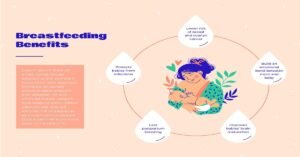Breast Feeding
Breast milk is the ideal food for babies up to six months of age. Breast milk has more benefits than other milk. Breast milk is ideal for meeting the physical, mental, and nutritional needs of the baby. Drinking breast milk benefits both mother and baby in many ways. Babies need 600 ml of milk a day. If the mother eats a nutritious diet during pregnancy and delivery, the baby gets all the calories it needs for the first six months from breast milk.
benefits of breastfeeding the baby are Nutritional Benefits-
Colostrum: Three to five days after birth, yellowish sticky milk is secreted from the mother’s breast, called colostrum. Compared to mature milk, this colostrum is lower in fat and lactose and higher in sodium, chlorine and zinc, and contains more of the antibody-rich proteins immunoglobulin A (IgA) and lactoferrin, which protect the baby from infection, and rids the baby of Miconium (neonate). black-colored first stool) helps to pass. Colostrum contains more PUFA (Poly Unsaturated Fatty Acid) than mature milk. Tryptophan. Colostrum is also rich in an amino acid essential for baby brain development. The baby should be given this milk after birth. Many people in our country do not drink this colostrum and throw it away due to misconception.Mature milk:
Colostrum turns into mature milk within a few days. This milk is rich in nutrients, hormones, active ingredients and globulins.Nutritional Value of breast milk:-
Carbohydrate:
The main carbohydrate in breast milk is lactose. Lactose helps in the absorption of calcium and phosphorus and helps to regulate the normal state of the intestinal flora. Lactose is digested to produce galactose. This galactose combines with lipids to form galactolipid compounds, which participate in forming the central nervous system. per 100 ml. About 7.4 gm in breast milk. Contains carbohydrates.Protein:
The major proteins in breast milk are lactoalbumin and lactoglobulin. Lactoalbumin is easily digested and absorbed. Protein helps in the baby’s normal growth and fulfills the essential amino acid requirement. Breast milk protein is rich in tryptophan and cistrin. The NPU of breast milk protein is 87. Taurine, an amino acid present in breast milk, helps in the development of the baby’s central nervous system. per 100 ml. Milk contains about 1.1 gm. Contains protein.Fats:
Fats provide the baby with essential energy, meet the baby’s essential fatty acid needs, and aid in the absorption of fat-soluble vitamins. Oleic in breast milk Acid and linoleic acid content is high. Linoleic acid baby Protects skin health. per 100 ml. About 3.4 gm in breast milk. Contains fat.Vitamins:
Vitamins present in breast milk are A, D, thiamin, riboflavin, nicotinic acid, pantothenic acid, and vitamins Bo, B₁₂ and C. Since the baby drinks breast milk directly, all the vitamins in the unchanged form help in infant nutrition. A lot of Vit in mother’s milk. vitamin A and Niacin.
Mineral Salts:
The baby needs a variety of mineral salts for nutrition, which the baby gets in moderation through breast milk. Mineral salts present in breast milk are calcium, phosphorus, chlorine, magnesium, potassium, sodium, copper, iodine, manganese, zinc, etc., and iron is also present in very small amounts.Benefits of breastfeeding-
- Immune benefits:The anti-parasitic components present immunoglobulins (Immunoglobulins): in breast milk are- ‘(1)Immunoglobulin-IgA, IgG, IgM, (2) Lysozyme, (3) Lactoper oxidase, (4) Lactoferrin,(5) Leukocytes, (6) Lactobacillus bifidus factor. , (7) monoglycerides and fatty acids.
Immunoglobulins in breast milk act as antibodies.
Breast milk contains high amounts of immunoglobulin A (IgA) antibodies and small amounts of IgG and IgM. IgA destroys various pathogens, especially- coli bacteria, poliovirus, streptococci, and pneumococci. Colostrum contains 20–40 mg (20–40mg/ml) of IgA per ml and mature milk contains 1 mg (1mg/ml) of IgA per ml.
- Lysozyme: Every ml of breast milk contains 2 mg (2mg/ml) of lysozyme. Lysozyme destroys bacteria by breaking down the bacterial wall.
- Lactoperoxidase: Helps destroy streptococci.
- Lactoferrin: It is an iron-containing protein, which is abundant in breast milk. It kills E. coli bacteria.
- White cells (Lymphoid cells): Various white cells are present in breast milk. Lymphocytes produce IgA. Neutrophils and macrophages destroy microbes by the process of phagocytosis.
- Lactobacillus Bifidus factor: Mother’s milk contains Bifidus factor (nitrogenous polysaccharide), which controls the growth of diarrhea-causing bacteria by increasing the growth of Lactobacillus Bifidus bacteria in the baby’s arms.
- Monoglycerides and fatty acids: Monoglycerides and fatty acids present in breast milk help the baby’s body fight against viruses and bacteria.
- Physiological Benefits:
Psychological benefits:
The baby comes very close to the mother while breastfeeding, thus developing a sincere bond between the two, a deep sense of security is created in the baby, both the baby and the mother. With extreme satisfaction, a psychological bond is formed between the two, thus between the child and the mother A good relationship is maintained throughout life and the child becomes empathetic towards the mother.Financial Benefits:
(i)Breastfeeding the baby saves the family money. Although there is some additional cost to meet the extra caloric needs of a nursing mother, it is much more economical than the cost of buying artificial milk. (ii) Infant feeding requires heating, a feeding bottle, and fuel. As a result, there is a financial cost for all those measures. However, breastfeeding does not have all these financial costs.Other benefits:
As the baby drinks directly from the mother’s milk, the chances of getting germs in the baby’s body are reduced. (ii) While drinking breast milk, the baby repeatedly presses the nipple with the help of gums, as a result, the baby’s gums become stronger the teeth erupt faster and the tooth structure is better. (iii) Mother’s milk contains anti-allergic substances so the baby is less likely to develop allergies. (iv) The child can be breastfed at any time, as per the child’s demand. (v) No prior preparation is required for feeding the baby. (vi) As breast milk is easily digestible, the baby is less prone to intestinal disturbances.Information on Breastfeeding
(ⅰ) The child should be given breast milk within half an hour of birth. (ii) For the first six months after birth, the child will drink only the mother’s milk.(iii) The child can be breastfed up to the age of two years.








1 thought on “5 Benefits of breastfeeding and Nutritional Value”